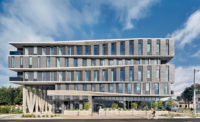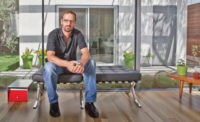Restaurateur Ben Edgerton recalls, "On paper, it didn't make any sense," describing the disparate elements that coalesced into Gardner, his latest venture with chef Andrew Wiseheart. Yet, in the end, the various components—smooth plaster walls are juxtaposed with custom-wrought steel fenestration and flaxen-colored brick opposite scorched cedar paneling—complement each other by mingling the clean lines of modernism with nature's sublime idiosyncracies.
Baldridge Architects wasn’t even on their radar until late in the process, when an artisan friend recommended the young local firm; it had already built an enviable reputation with work, mostly residential, admired for being finely articulated and acutely responsive to surrounding nature. According to Edgerton, the firm’s aesthetic was in harmony with the vision he and his partner Wisehart had for the restaurant.
The site, located on the city’s rapidly developing near east side, had been a neighborhood post office. Newly subdivided, the single-story building had a loading dock at its east end. Principal Burton Baldridge and project designer Brian Bedrosian reimagined the utilitarian functionality of the rectangular 1960s building clad in government-issue golden hued brick. Interiors consultants Charyl Coleman and Anne Lowe Edgerton provided additional expertise.
Simplicity and operational efficiency drove all design decisions; everything, from architecture and furnishings to service and food, must work together. “We wanted the entire experience to be cohesive,” explains Wiseheart, who named Gardner in honor of his father, an exuberant gourmet like his son.
That experience begins with patrons entering Gardner’s minimalist foyer, a deliberately compressed, visually sequestered space. They are then guided either to an open-air lounge to the east or an adjoining steel-and-glass-enclosed bar to the northeast, both adaptations of the old loading dock, while they wait to be seated. To expand the bar space, Baldridge sourced matches for the period brick at the original foundry nearby. The opposite wall features floor-to-ceiling horizontal planks of cedar, charred by hand in the Japanese shou-sugi-ban style.
These tactile qualities, though subdued, disappear in the dining area, where Baldridge opted to “turn down the volume” to avoid competition with the food. The ambience is distinctly muted, with earth tones and walls free of artwork. Instead, profuse daylight animates the large open space, streaming down from a linear skylight inconspicuous in its placement, high within a long, slim, wood-clad slot in the ceiling. This striking arrangement overhead, which discreetly masks an expansive mechanicals loft, lifts one’s gaze toward a tall, narrow opening revealing the 1,000-square-foot kitchen. Reinforcing the optical choreography, two slender service islands run longitudinally in tandem through the room, an organizational scheme that also reduces time and effort for the wait staff in attending to Gardner’s guests.
The methodically orchestrated experience climaxes with the arrival of one’s meal. Hand-crafted dining tables, simply set with the basics, recede into the background, showcasing artfully presented seasonal dishes, such as okra accompanied by hazelnut, shishito, and serrano ham, or panisse garnished with field peas, peach, and pickled ramps.
Baldridge, when recounting the challenges and triumphs of the project, obviously relished the opportunity to counterbalance what he sees as “a ridiculous lack of restraint” among the city’s better restaurants. Gardner, he says proudly, stands apart by being “decidedly unlike Austin.”
PeopleClient: Ben Edgerton and Andrew Wiseheart Owner: Edgewise, LLC Architect: Personnel in architect's firm who should receive special credit: Interior decorator: Charyl Coleman, Anne Edgerton Interiors Engineers: General contractor: Franklin Alan Photographer(s): Size: 3,830 square feet Cost: withheld Completion date: November 2014 |
ProductsStructural system Exterior cladding Metal/glass curtain wall: see window system below Rainscreen: Shou Sugi Ban (by clients) Wood: (see rainscreen above) Other cladding unique to this project: Stacked post oak (by clients) Windows Metal frame: Superior General Contracting: fabrication of custom steel + glass storefront system @ front door, patio, bar + lounge, skylight (design by Baldridge Architects) Glazing Skylights: (same as “windows” above) Other: Doors Metal doors: (see above) Wood doors: Commercial Doors and Hardware Special doors: Upswinging doors, other: Hardware Interior finishes Cabinetwork and custom woodwork: Tim Cuddy: fabrication of bar, booth, window/skylight sleeves, service island, and all built in cabinetry (design by Baldridge Architects) Paints and stains: Benjamin Moore Wall coverings: (see paints / plaster / masonry below) Paneling: #2 common White Oak installed by Tim Cuddy (see cabinetwork above) Solid surfacing: One-Pointe Solutions / Chem Tops - Epoxy Resin Countertop (service islands) Resilient flooring: Shur Step Flooring (anti-fatigue flooring in kitchen), W+W Distributing (installer) Special interior finishes unique to this project: Furnishings Chairs: Michael Yates Design – custom chairs + bar stools (design + fabrication by Michael Yates Design) Tables: Michael Yates Design (design + fabrication by Michael Yates Design) Upholstery: Spruce Upholstery Other furniture: Lighting Soft Dog pendant: designed by Henrik Pedersen (sourced from Design Within Reach) Downlights: Cooper Lighting Task lighting: Tech Lighting Exterior: Vista Lighting Plumbing |













Post a comment to this article
Report Abusive Comment